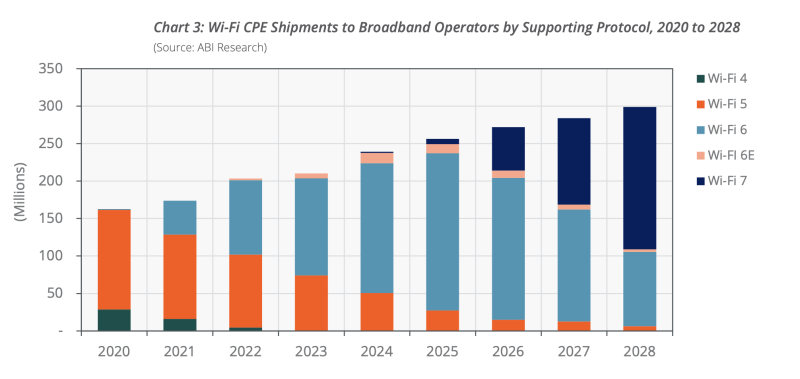SAN DIEGO —The new Wi-Fi 7 standard, which is expected to be ready in 2024, is poised to deliver a big upgrade in performance over Wi-Fi 6E including theoretical speeds of over 40 Gbps.
During a Qualcomm Wi-Fi 7 Day event here last week, executives from Qualcomm and other tech firms talked to analysts and members of the media about Wi-Fi 7's advantages and their expectations for the technology.
Wi-Fi 7 builds upon the foundation started with Wi-Fi 6 and Wi-Fi 6E but also includes 320 MHz bandwidth channels and 4K QAM modulation. It also includes a snazzy new feature, called multi-link operation (MLO) that is similar to carrier aggregation in the cellular world. MLO allows for the aggregation of multiple different radio links in different spectrum bands resulting in higher throughputs and reduced network congestion. Plus, MLO also reduces latency because it can switch between the different available radio links.
According to ABI Research, MLO will be particularly beneficial for certain use cases such as large file downloads, video streaming and virtual reality because it can “unlock higher throughputs by aggregating separate radio links to create wide channels in congested environments.”
But Wi-Fi 7 isn’t the only factor contributing to the huge innovations that are expected to occur in the Wi-Fi world over the next year. The other reason is the FCC’s recent allocation of 1,200 MHz of 6 GHz spectrum for unlicensed use. This new spectrum allotment basically triples the amount of unlicensed spectrum available for Wi-Fi in the U.S.
The result, according to Nick Weaver, co-founder and CEO of eero, a Wi-Fi mesh company owned by Amazon, is that Wi-Fi 7 will be able to deliver speeds that are faster than many Ethernet connections inside homes. This performance leap is expected to prompt many broadband operators to upgrade to Wi-Fi 7 to take advantage of the benefits of the technology and differentiate from their competitors.
ABI Research predicts Wi-Fi 7 devices (gateways, routers, extenders, etc.) will begin to hit the market this year, and by 2028 shipments of Wi-Fi 7 CPEs will surpass those of Wi-Fi 6E CPEs.

Qualcomm goes 10G
To entice the move to Wi-Fi 7, Qualcomm is entering the 10G fiber market with a 10G Fiber Gateway Platform that pairs Wi-Fi 7 with 10G passive optical network (PON) connectivity and includes Qualcomm’s service-defined Wi-Fi technology. The platform is designed to enable 10 Gbps speeds through the home and includes Qualcomm’s service-defined Wi-Fi technology that helps improve customer experience with a cloud-native framework that lets broadband providers provision the home gateway and control the services on the network. Specifically, it can monitor traffic flows in real-time and optimize the different applications.
Ganesh Swaminathan, VP and GM of wireless infrastructure and networking at Qualcomm Technologies, said that the 10G Fiber Gateway Platform is interoperable with existing operator optical line terminals (OLTs).
Charter Communications is collaborating with Qualcomm on the next-gen platform so it can deliver Wi-Fi 7 and 10 Gbps Wi-Fi speeds to its Spectrum Internet users. The Wi-Fi 7 platform will leverage MLO and deliver connectivity from all three Wi-Fi bands — 2.4 GHz, 5 GHz and 6 GHz — to increase throughput and capacity. Charter said it expects the new Wi-Fi 7 routers to be available to Spectrum customers in 2024.
Gary Koerper, senior vice president of emerging technologies at Charter, announced the collaboration at Qualcomm’s Wi-Fi 7 event, and said that Spectrum already uses Qualcomm’s Advanced Wi-Fi platform to deliver Wi-Fi services to its customers and provide managed connectivity and additional security.
Spectrum also offers a service it calls Speed Boost, which it debuted in 2022. Speed Boost is a feature available to Spectrum Mobile customers that also have Spectrum Internet. When Spectrum Mobile customers are connected to Spectrum’s Advanced Wi-Fi they experience faster Wi-Fi speeds at no additional cost.
“If you have a Spectrum Mobile phone on our Wi-Fi network we can see it and manage it,” Koerper said, adding that some Spectrum Mobile customers get download speeds of up to 1 Gbps on their devices today even though they are only paying for a 300 Mbps speed tier for their home broadband service.
But Charter isn’t the only operator setting its sights on Wi-Fi 7. U.K. operator EE also announced it is working with Qualcomm to incorporate Wi-Fi 7 into the company’s next-gen home broadband Smart Hub with plans to launch the device in 2024.
The company currently offers the EE Smart Hub Plus that uses the Wi-Fi 6 standard. However, Wi-Fi 7’s 320 MHz channel bandwidth is appealing to EE because it expects to double the number of Wi-Fi connected devices in the home over the next five years which will result in more demands for Wi-Fi capacity.
Danny Marshall, device portfolio director at EE, which is part of BT, said that BT recently accelerated its fiber rollout plans to provide nationwide fiber coverage and this is prompting the company to pay more attention to the customer experience and upgrade to Wi-Fi 7.
“Wi-Fi 7 will give us the hardware and technology platform to enable us to remove bottlenecks and deliver what our customers need,” he said.